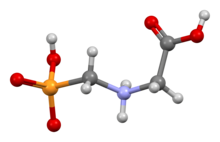Glyphosate
The WHO and FAO Joint committee on pesticide residues issued a report in 2016 stating the use of glyphosate formulations does not necessarily constitute a health risk, and giving an acceptable daily intake limit of 1 milligram per kilogram of body weight per day for chronic toxicity.
"[32] As of April 2017, the Canadian government stated that glyphosate was "the most widely used herbicide in Canada",[33] at which date the product labels were revised to ensure a limit of 20% POEA by weight.
This avoids the need for decarboxylation but requires more careful control of stoichiometry, as the primary amine can react with any excess formaldehyde to form bishydroxymethylglycine, which must be hydrolysed during the work-up to give the desired product.
This synthetic approach is responsible for a substantial portion of the production of glyphosate in China, with considerable work having gone into recycling the triethylamine and methanol solvents.
[52] Glyphosate interferes with the shikimate pathway, which produces the aromatic amino acids phenylalanine, tyrosine and tryptophan in plants and microorganisms[53] – but does not exist in the genome of animals, including humans.
[67] Glyphosate and related herbicides are often used in invasive species eradication and habitat restoration, especially to enhance native plant establishment in prairie ecosystems.
[72][74] Because glyphosate is systemic, excess residue levels can persist in plants due to incorrect application and this may render the crop unfit for sale.
[81] Current glyphosate-resistant crops include soy, maize (corn), canola, alfalfa, sugar beets, and cotton, with wheat still under development.
In 2023, 91% of corn, 95% of soybeans, and 94% of cotton produced in the United States were from strains that were genetically modified to be tolerant to multiple herbicides, including dicamba, glufosinate, and glyphosate.
[87] Glyphosate does have the potential to contaminate surface waters due to its aquatic use patterns and through erosion, as it adsorbs to colloidal soil particles suspended in runoff.
[107] Inhalation is a minor route of exposure, but spray mist may cause oral or nasal discomfort, an unpleasant taste in the mouth, or tingling and irritation in the throat.
[121] Glyphosate can control the growth of apicomplexan parasites, such as Toxoplasma gondii, Plasmodium falciparum (malaria), and Cryptosporidium parvum, and has been considered an antimicrobial agent in mammals.
[104] Inhalation is a minor route of exposure, but spray mist may cause oral or nasal discomfort, an unpleasant taste in the mouth, or tingling and irritation in the throat.
[143] Aquatic organism exposure risk to terrestrial formulations with POEA is limited to drift or temporary water pockets where concentrations would be much lower than label rates.
[citation needed] The IARC monograph noted that glyphosate-based formulations can cause DNA strand breaks in various taxa of animals in vitro.
[149][150][151] In November 2015, EFSA published its conclusion in the Renewal Assessment Report (RAR), stating it was "unlikely to pose a carcinogenic hazard to humans".
"[12] In contrast, a 2016 analysis by Christopher Portier, a scientist advising the IARC in the assessment of glyphosate and advocate for its classification as possibly carcinogenic, concluded that in the EFSA's Renewal Assessment Report, "almost no weight is given to studies from the published literature and there is an over-reliance on non-publicly available industry-provided studies using a limited set of assays that define the minimum data necessary for the marketing of a pesticide", arguing that the IARC's evaluation of probably carcinogenic to humans "accurately reflects the results of published scientific literature on glyphosate".
[93] The EPA considered a "worst case" dietary risk model of an individual eating a lifetime of food derived entirely from glyphosate-sprayed fields with residues at their maximum levels.
[170] In 2017, evidence collected in a lawsuit brought against Monsanto by cancer patients revealed company emails which appeared to show a friendly relationship with a senior EPA official.
Miller did not reveal the connection to Forbes, and according to the New York Times, when Monsanto asked him if he was interested in writing such an article, he replied "I would be if I could start from a high-quality draft" provided by the company.
[201][200] Conyza bonariensis (also known as hairy fleabane and buva) and C. canadensis (known as horseweed or marestail) are other weed species that have lately developed glyphosate resistance.
[208] Use of glyphosate and other herbicides like 2,4-D to clear milkweed along roads and fields may have contributed to a decline in monarch butterfly populations in the Midwestern United States.
[211][212] The Natural Resources Defense Council (NRDC) filed a suit against the EPA in 2015, in which it argued that the agency ignored warnings about the potentially dangerous impacts of glyphosate usage on monarchs.
[222] The date was subsequently pushed back, partially due to very high interest and input in the participation process, with the European Food Safety Authority (EFSA) even calling it an “unprecedented number”.
[227] In June 2015, the French Ecology Minister asked nurseries and garden centers to halt over-the-counter sales of glyphosate in the form of Monsanto's Roundup.
[230][231] In March 2019, the Austrian state of Carinthia outlawed the private use of glyphosate in residential areas while the commercial application of the herbicide is still permitted for farmers.
[245] In addition, the state of California attempted to enforce a requirement for a Prop 65 carcinogen warning label on glyphosate containers, but was permanently enjoined from doing so by a federal court.
[253] In August 2020, Mexican President Andrés Manuel López Obrador announced that glyphosate would be gradually phased out of use in Mexico by late 2024.
[262][263] Since 2018, in a number of court cases in the United States, plaintiffs have argued that their cancer was caused by exposure to glyphosate in glyphosate-based herbicides produced by Monsanto/Bayer.
[264] In 2016, a lawsuit was filed against Quaker Oats in the Federal district courts of both New York and California after trace amounts of glyphosate were found in oatmeal.










